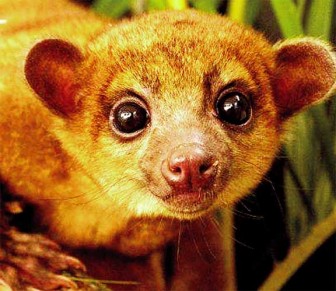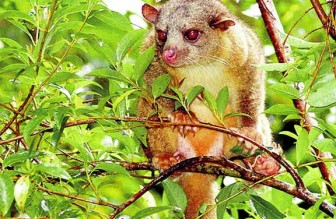Kinkajous (Potos Flavus), also known as Night Monkeys or Honey Bears, and Olingos (genus Bassaricyon) are both members of the Racoon family. Kinkajous weigh about 2-3 kg and are about 40-60 cm in length with a prehensile tail approximately 40-55 cm long. They have a brown-grey coloured outer coat with large eyes, small ears, short legs and a slender extrudable tongue.
Olingos are similar but lack prehensile tails and extrudable tongues, and have more extended muzzles. Both live solitary lives in the forest canopy and are nocturnal by nature. It is very difficult to tell Kinkajous and Olingos apart. When these animals were first collected in the Iwokrama Forest during a faunal survey, mammologist Burton Lim realised that one of the animals was an Olingo and not a Kinkajou. This event marked the first recorded sighting of an Olingo in Guyana for over 75 years.

![]() Kinkajous are known to form treetop groups and interact socially for example carrying out reciprocal grooming. They are quite vocal and can be heard screeching and barking in the canopy.
Kinkajous are known to form treetop groups and interact socially for example carrying out reciprocal grooming. They are quite vocal and can be heard screeching and barking in the canopy.
Olingos are less social, tending to be more solitary.
Both Olingos and Kinkajous are omnivorous, eating insects, small mammals and fruits.
Kinkajous particularly like raiding honey from beehives and nectar from flowers.
The Olingo is more carnivorous. Both species appear to breed year round producing a single young.
They reach

maturity between 18-24 months.
Rain forests are rich in biodiversity and are home to many different plants and animals. In addition, indigenous communities make their homes there. Even if you don’t live in the rain forest, humans rely on the forest for resources such as building materials (wood and lianas), medicine and fruits. Rain forests also provide essential environmental services for life on earth; they create soil as well as prevent soil erosion, produce oxygen though photosynthesis, maintain clean water systems, and are a key defence against climate change.
The Iwokrama Rain Forest is 371,000 hectares, located in the heart of Guyana. Our mission is to develop strategies for conservation and sustainable development for local people in Guyana and the world at large. We are involved in tourism, training, research and our timber is certified by the Forest Stewardship Council. Come and visit us in the rain forest or at http://www.iwokrama.org.









